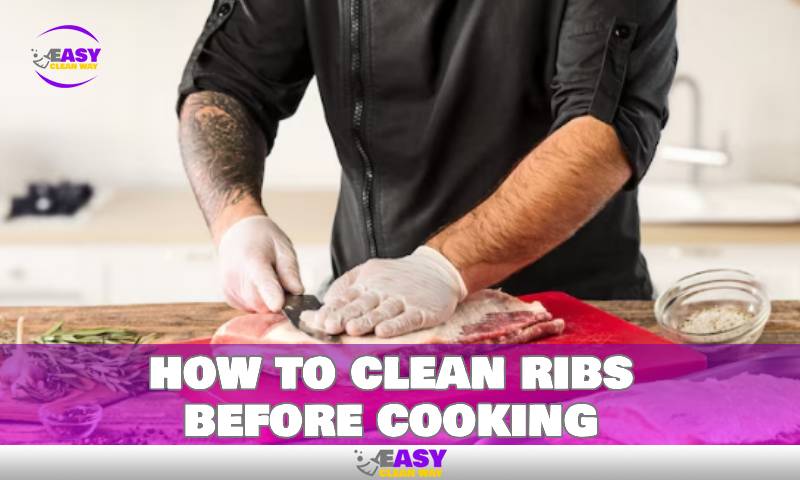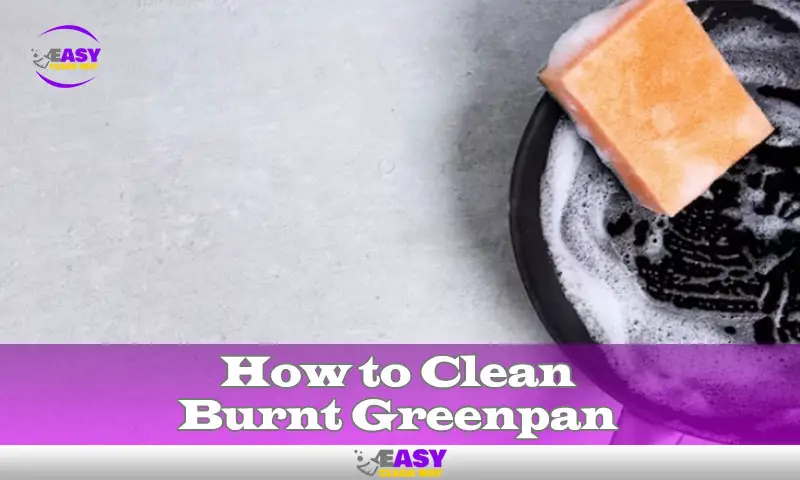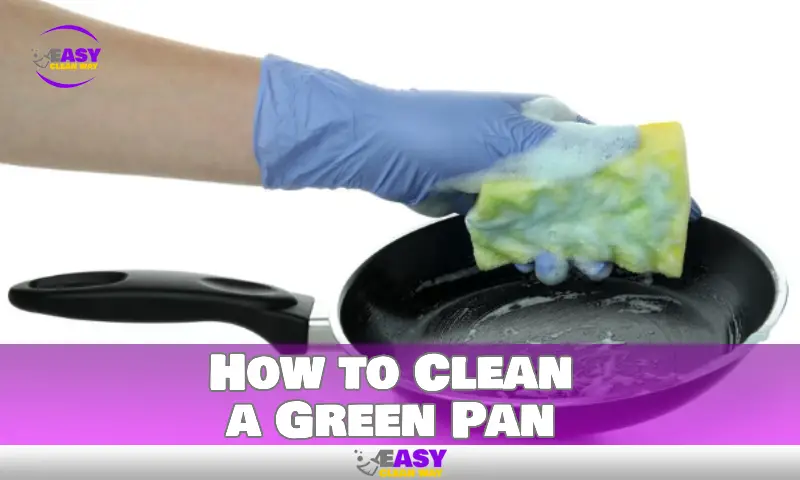To clean ribs before cooking, remove the membrane and excess fat with a sharp knife or your fingers. Then rinse the ribs under cold water, pat them dry, and season as desired.
When preparing ribs for cooking, it is important to clean them properly to achieve the best flavor and texture. By removing the membrane and excess fat, you can enhance the tenderness of the meat and allow the flavors to penetrate more effectively.
This can be done easily with a sharp knife or by using your fingers to peel off the membrane. After that, give the ribs a quick rinse under cold water to remove any debris, pat them dry with a paper towel, and season them with your preferred seasoning or marinade. By following these simple steps, you can ensure that your ribs are clean and ready for a delicious cooking experience.
Why Cleaning Ribs Is Essential For Delicious Results
Cleaning ribs before cooking is a crucial step that should never be overlooked. It not only ensures food safety but also plays a significant role in the flavor and tenderness of the final dish. By removing any residual debris and giving the ribs a thorough clean, you can achieve delicious results that will have everyone coming back for more.
Understanding The Impact Of Residual Debris On Cooking
When you purchase ribs from the store or butcher, they often come with residual debris such as bone fragments, excess fat, and tough membranes. These remnants can negatively impact the cooking process and result in an unpleasant eating experience. Here’s why:
- Bone fragments: These small, sharp pieces can pose a choking hazard and ruin the overall enjoyment of the meal.
- Excess fat: A thin layer of fat is desirable for flavor and moisture, but too much fat can lead to greasy and heavy ribs.
- Tough membranes: Ribs are typically covered by a thin membrane on the bone side. If left intact, this membrane can become chewy and create resistance when trying to bite into the cooked ribs.
To ensure a pleasant dining experience and avoid any unwanted surprises, it is important to clean the ribs thoroughly before cooking.
How Cleaning Enhances Seasoning And Marinade Absorption
Cleaning ribs not only removes debris but also creates a clean canvas for seasoning and marinade absorption. By taking the time to clean your ribs properly, you can maximize the flavor profile and enhance the overall taste of the dish.
Here’s how cleaning enhances seasoning and marinade absorption:
- Removing debris: Cleaning the ribs ensures there are no residual bone fragments or undesired bits that can prevent seasoning and marinade from adhering to the meat properly.
- Opening up pores: By cleaning the surface of the ribs, you are essentially opening up the pores of the meat. This allows the seasoning and marinade to penetrate and infuse the meat, resulting in more flavorful and delicious ribs.
- Better distribution: When the ribs are clean, the seasoning and marinade can evenly distribute across the meat’s surface, ensuring that each bite is packed with flavor.
Cleaning your ribs before cooking is a simple yet essential step that can make a significant difference in the taste and overall experience of your dish. Don’t skip this crucial step and enjoy mouthwatering, flavorful ribs that will leave your guests wanting more.
Gathering The Necessary Tools And Ingredients

Before diving into the process of cleaning ribs, it’s important to gather all the necessary tools and ingredients. Ensuring that you have everything you need will make the task much easier and more efficient. Here are the key items you’ll need:
Knife and cutting board for trimming excess fat:
- A sharp knife and sturdy cutting board are essential for efficiently trimming excess fat from the ribs.
- Ensure that the knife is sharp to ensure precise cuts and avoid accidents.
- A stable cutting board will provide a solid surface for easy trimming.
Disposable gloves for hygiene and handling:
- It’s crucial to prioritize hygiene when handling raw meat, and disposable gloves are a great way to ensure cleanliness.
- Wearing gloves will help prevent the spread of bacteria and reduce the risk of cross-contamination.
- Choose gloves that fit comfortably and enable you to handle the ribs with ease.
Paper towels for drying ribs:
- Drying the ribs before cooking is essential, as excess moisture can hinder the absorption of seasonings and sauces.
- Paper towels are perfect for this task, as they effectively absorb moisture without leaving any residue.
- Have an ample supply of paper towels on hand to ensure thorough drying.
Cleaning solution for removing surface bacteria:
- Before cooking, it’s important to remove any surface bacteria from the ribs.
- You can use a cleaning solution specifically designed for meat or a mixture of vinegar and water.
- The cleaning solution will help eliminate bacteria and provide a clean base for seasoning and cooking.
Remember, having all these tools and ingredients ready before you start cleaning your ribs will save you time and ensure a smooth cooking process. So, let’s gather everything and proceed to the next steps!
Removing The Membrane: A Crucial Step In Prepping Ribs
When it comes to preparing ribs for cooking, there is one step that often gets overlooked but is actually crucial for achieving tender and flavorful results – removing the membrane. This thin, papery layer on the backside of the rib rack can prevent seasonings and marinades from fully penetrating the meat, resulting in less flavorful ribs.
Additionally, the membrane can become tough and chewy when cooked, detracting from the overall enjoyment of the dish. Thankfully, with a few simple techniques, you can easily remove this membrane and elevate your rib game to the next level.
Understanding The Purpose Of The Membrane:
- The membrane, also known as the silver skin, is a connective tissue that covers the bone side of the ribs.
- Its main purpose is to protect the ribs and provide structural support.
- However, leaving the membrane intact can hinder flavor absorption and impact the texture of the cooked ribs.
Techniques For Easily Removing The Membrane:
Method 1: Using A Paper Towel Or Cloth
- Starting from one end of the rack, grab the membrane with a paper towel or cloth to enhance grip.
- Gently lift and loosen the membrane by wedging your finger or a butter knife between the membrane and the bone.
- Once loosened, carefully peel and pull the entire membrane off in one motion.
Method 2: Using A Knife Or Kitchen Shears
- Make a small incision in the membrane near the edge of the rack using a sharp knife or kitchen shears.
- Insert a butter knife or your finger underneath the membrane, ensuring it is lifted from the bone.
- Slowly and steadily work your way across the rack, using the knife or shears to separate the membrane from the bone.
- Once the entire membrane is loosened, grab hold of it with a paper towel or cloth and peel it off completely.
The Benefits Of Membrane Removal For Tenderness And Flavor:
- By removing the membrane, you create channels for flavors to penetrate the meat fully. This allows seasonings, marinades, and smoke to infuse into the ribs, enhancing their taste.
- Without the membrane, the ribs have the opportunity to become more tender during the cooking process. The collagen in the connective tissue breaks down, resulting in a more succulent and enjoyable eating experience.
- Removing the membrane also allows for better bark formation on the surface of the ribs. The bark, a flavorful crust that develops during cooking, adds texture and depth to each bite.
So, the next time you’re prepping ribs for your barbecue feast, don’t forget this crucial step. Take the time to remove the membrane, and you’ll be rewarded with ribs that are full of flavor, tender, and truly irresistible. Get ready to impress your family and friends with your newfound rib-prepping skills.
Trimming Excess Fat: Achieving An Ideal Rib Composition
When it comes to cooking ribs, achieving the perfect balance of fat is essential to ensure juicy, tender meat with a delicious flavor. Identifying areas of excessive fat on ribs, employing proper techniques for trimming fat without compromising taste, and understanding the impact of fat removal on cooking time and texture are all crucial steps in creating the ultimate rib masterpiece.
Identifying Areas Of Excessive Fat On Ribs
Excessive fat on ribs can result in an unappetizing greasy texture and can also shield the meat from absorbing flavors during cooking. By identifying and removing these fatty areas, you can enhance both the taste and texture of your ribs. Here are some key points to consider:
- Look for thick, white layers of fat covering the rib meat. These areas usually indicate excessive fat that can be trimmed.
- Examine the edges of the ribs for excessive fat deposits as well. These portions tend to be tougher and less flavorful due to the presence of excess fat.
- Pay attention to the marbling within the meat itself. While some marbling is desirable for flavor, excessive marbling can contribute to an overly fatty final product.
Proper Techniques For Trimming Fat Without Compromising Taste
Knowing how to trim the fat effectively enables you to strike the right balance between flavor and tenderness. Here are the proper techniques for trimming fat without compromising taste:
- Use a sharp knife to carefully slice away the excess fat. Make sure to maintain a steady hand and remove only the visible fat layers, avoiding excessive cuts into the meat itself.
- Consider using a technique called “scoring” to improve flavor penetration. This involves making shallow cuts into the remaining fat to create small pockets that allow seasonings and sauces to infuse the meat.
- Remember to remove any thin membranes covering the ribs. These membranes can prevent flavors from permeating the meat during cooking, so peeling them off is crucial.
The Impact Of Fat Removal On Cooking Time And Texture
It’s important to note that removing excessive fat can affect both the cooking time and the texture of your ribs. Here’s what you need to know:
- With less fat to insulate and moisten the meat, cooking times may be slightly reduced. Keep a close eye on your ribs during cooking to ensure they don’t become overdone.
- Thinner layers of fat can result in a leaner, firmer texture. While this may appeal to some, it’s essential to find a balance that retains juiciness without compromising tenderness.
- Consider using alternative cooking methods, such as slow smoking or braising, to retain moisture and add tenderness to leaner ribs.
By identifying areas of excessive fat, employing proper trimming techniques, and understanding the impact of fat removal on cooking time and texture, you can achieve the ideal rib composition that is both flavorful and succulent.
Washing And Drying Ribs: Ensuring Cleanliness And Moisture Control
Washing ribs before cooking is a crucial step in ensuring cleanliness and eliminating impurities that might affect the taste and safety of your delicious meal. By taking the time to properly wash your ribs, you can remove any dirt, bacteria, or unwanted substances, allowing you to enjoy the pure flavors of the meat.
Here are the key points to remember:
- Washing ribs remove any surface debris, such as bone fragments or loose seasoning, that may have accumulated during transportation or handling.
- It helps to eliminate bacteria or contaminants that might be present on the surface of the meat, reducing the risk of foodborne illnesses.
- Properly washed ribs result in a cleaner cooking process, ensuring that the final dish is safe and enjoyable for you and your guests.
Techniques For Effectively Washing Ribs
Now that you understand the importance of washing ribs, let’s explore some effective techniques to ensure cleanliness.
Consider these points:
- Begin by rinsing the ribs under cold, running water. This helps to remove any loose particles, blood, or marinade residue.
- Use gentle scrubbing action with a clean, food-grade brush to thoroughly clean the entire surface of the ribs.
- If desired, you can also soak the ribs in a mixture of water and vinegar for a few minutes. This helps to kill bacteria and tenderize the meat.
- After washing, pat the ribs dry with paper towels to remove excess moisture.
Remember, proper washing techniques guarantee the safety and quality of your ribs, ensuring a delightful culinary experience.
The Necessity Of Proper Drying To Enhance Seasoning Adherence
After washing your ribs, proper drying is essential to ensure that seasonings adhere well and enhance the flavor of the meat. It also helps to achieve a nice crust or char when grilling or smoking.
Consider the following points:
- Drying the surface of the ribs removes excess moisture, allowing seasonings to stick better and penetrate the meat.
- Leave the ribs uncovered in the refrigerator for a few hours or overnight to air dry. This promotes better-seasoning adherence and helps form a flavorful crust.
- If you’re in a hurry, you can also use a clean kitchen towel to gently pat the ribs dry before applying seasonings.
- Dry ribs result in better browning and caramelization during cooking, enhancing the overall taste and appearance of the final dish.
Proper drying of ribs is essential for optimal seasoning adherence and mouthwatering results. So, take the time to dry your ribs before cooking, and you’ll be rewarded with barbecue goodness!
Applying A Cleaning Solution: Eliminating Bacteria And Enhancing Safety
When it comes to preparing ribs for cooking, proper cleaning is essential to ensure the safety and hygiene of the final dish. Applying a suitable cleaning solution not only eliminates harmful bacteria but also enhances the overall flavor and tenderness of the meat.
In this section, we will explore the key points to consider when choosing a cleaning solution for ribs, as well as the proper application and soaking time for maximum effectiveness.
Choosing A Suitable Cleaning Solution For Ribs
- Vinegar: Vinegar is a versatile and effective cleaning solution for ribs. Its acidic properties help eliminate bacteria, remove dirt, and tenderize the meat.
- Lemon juice: Lemon juice contains natural acids that can effectively cleanse the ribs and add a tangy flavor. It also helps break down tough fibers for tender and succulent meat.
- Saltwater solution: A simple saltwater solution can help draw out impurities and kill bacteria on the surface of the ribs. It is a cost-effective and easy-to-use cleaning option.
Proper Application And Soaking Time For Maximum Effectiveness
- Rinse the ribs: Before applying any cleaning solution, rinse the ribs thoroughly under cold running water to remove loose particles and debris.
- Apply the cleaning solution: Depending on the chosen cleaning solution, either massage it onto the ribs with your hands or submerge them in a container filled with the solution.
- Soak time: Allow the cleaning solution to penetrate the meat by letting the ribs soak for at least 30 minutes. This will help break down any remaining impurities and enhance the flavor.
- Rinse again: After the soaking period, rinse the ribs under cold running water to remove any residual cleaning solution. This step ensures that no overpowering flavors are left on the meat.
Ensure the safety and hygiene of cooked ribs:
- Separate cutting surfaces: To prevent cross-contamination, use separate cutting boards and utensils for raw and cooked ribs.
- Cook thoroughly: Always cook ribs to the recommended internal temperature to kill any remaining bacteria. This will ensure that your ribs are safe to consume.
- Storage: Properly store any leftover cooked ribs in sealed containers and refrigerate them promptly to prevent bacterial growth.
- Hygiene practices: Follow good hygiene practices by washing your hands before and after handling raw ribs, as well as any other ingredients or utensils involved in the cooking process.
By selecting a suitable cleaning solution, applying it correctly, and following proper safety and hygiene practices, you can ensure delicious and safe-to-eat ribs. Enjoy a mouthwatering meal while prioritizing cleanliness and food safety.
Final Tips And Precautions For Cleaning Ribs

Before you embark on the delicious journey of cooking ribs, it is essential to understand the importance of proper cleaning and handling of this delectable meat. In this section, we will discuss some final tips and precautions to ensure that your ribs are safe, tasty, and free from any harmful contaminants.
Storing And Handling Ribs Safely To Prevent Contamination
To guarantee the safety of your ribs and prevent any potential contamination, it is crucial to follow proper storage and handling techniques. Here are some key points to keep in mind:
- Store ribs in the refrigerator at a temperature below 40°f (4°c) to inhibit the growth of bacteria.
- Use airtight containers or resealable bags to prevent leaks and cross-contamination with other food items.
- Always practice good hygiene by washing your hands thoroughly before and after handling raw ribs.
- Use separate cutting boards, knives, and utensils for raw meat to avoid cross-contamination with other ingredients.
Avoiding Cross-Contamination With Other Ingredients
Cross-contamination can occur when bacteria from raw meat come into contact with other food items, leading to potential foodborne illnesses. Here’s how you can prevent it:
- Keep raw ribs away from other foods, especially those that will be consumed without further cooking, such as salads or fruits.
- Clean and sanitize any surfaces or utensils that come into contact with raw ribs before using them for other ingredients.
- Use separate plates or containers for cooked ribs to prevent any juices from contaminating other foods during serving.
Proper Disposal Of Rib Scraps And Cleaning Materials
After cleaning and handling ribs, it is essential to dispose of any rib scraps and cleaning materials properly. Here are some tips to ensure a safe and clean environment:
- Seal rib scraps in airtight bags and discard them immediately in a covered trash bin to prevent any odor or pest issues.
- Clean all surfaces, utensils, and cutting boards used for rib preparation with hot, soapy water to remove any lingering bacteria.
- Sanitize these items using a solution of one tablespoon of bleach per gallon of water, or follow the manufacturer’s instructions for sanitizing agents.
Remember, by adhering to these final tips and precautions, you can ensure that your ribs are not only delicious but also safe to eat. Following proper cleaning and handling practices is essential to keep your cooking environment free from contamination and maintaining the highest standards of food safety.
So, roll up your sleeves, get ready to fire up that grill, and enjoy the tender, flavorful ribs you’ve prepared with care.
Recap The Importance Of Cleaning Ribs For Optimal Cooking
Cleaning ribs before cooking is an essential step in preparing mouthwatering and flavorful dishes. By taking the time to properly clean your ribs, you can ensure delicious results and enhance the overall tenderness of the meat. Here’s a recap of why cleaning ribs is crucial for optimal cooking:
- Removing excess fat: Cleaning ribs involves removing any excess fat present in the meat. This not only makes the ribs healthier but also prevents flare-ups on the grill or excessive greasiness in the finished dish.
- Getting rid of membrane: The membrane found on the underside of the ribs can be tough and chewy if left on. By removing it, you allow the seasonings and flavors to penetrate the meat, resulting in a more enjoyable eating experience.
- Enhancing flavor absorption: Cleaning ribs allows for better flavor absorption during the cooking process. By thoroughly cleaning the surface of the ribs, you create a clean slate for seasonings, marinades, and rubs to stick to, enhancing the overall taste of the ribs.
- Promoting tenderness: Properly cleaning the ribs helps break down the connective tissues and makes the meat more tender. This step ensures that every bite of your ribs is succulent and enjoyable.
Emphasize The Impact Of Proper Cleaning Techniques On Flavor And Tenderness
Proper cleaning techniques play a vital role in ensuring the flavor and tenderness of your ribs. By following these techniques, you can elevate your rib-cooking game and create a truly delicious dish:
- Scrape off the membrane: Use a sharp knife or your fingers to pry up a corner of the membrane on the underside of the ribs. Once you have a good grip, slowly pull it away from the meat, ensuring that the entire membrane is removed.
- Trim excess fat: With a sharp knife, carefully trim any excess fat from the surface of the ribs. Be mindful not to remove all the fat, as it adds flavor and moisture to the meat during the cooking process.
- Rinse under cold water: Thoroughly rinse the ribs under cold running water to remove any bone fragments or debris that may be present.
- Pat dry: After rinsing, gently pat the ribs dry using paper towels. This step helps achieve a better sear on the meat and prevents excess moisture during cooking.
By following these cleaning techniques, you’ll create the perfect canvas for your preferred flavors and cooking methods, ensuring tender and flavorful ribs every time.
FAQ
How Do You Clean Ribs Before Cooking?
To clean ribs before cooking, remove the thin membrane on the back, rinse under cold water, and pat dry.
Should I Marinate Ribs Before Grilling?
Marinating ribs before grilling is recommended, as it helps enhance the flavor and tenderize the meat.
What Is The Best Way To Remove The Membrane From Ribs?
The best way to remove the membrane from ribs is by using a knife to loosen it from the bone, then gripping it with a paper towel and peeling it off.
Conclusion
To ensure delicious and tender ribs, it is crucial to properly clean them before cooking. By following the steps outlined in this blog post, you can remove any excess blood and lingering debris, ensuring a clean and appetizing final dish.
Begin by rinsing the ribs under cold water, then use a sharp knife to remove the membrane. A combination of vinegar and water or a citrus-based marinade can effectively sanitize the surface and enhance the flavor. Don’t forget to thoroughly wash your hands and all utensils used in the cleaning process to maintain hygiene.
Taking the time to clean your ribs before cooking will not only result in a better-tasting meal but also prevent potential health risks. So, next time you’re preparing ribs, remember these cleaning tips to achieve mouthwatering and safe results. Enjoy your cooking!
Hey there! I’m Alton Smith, your Clean Expert blogger. I’m on a quest to help you conquer chaos and embrace the joys of a tidy life.





